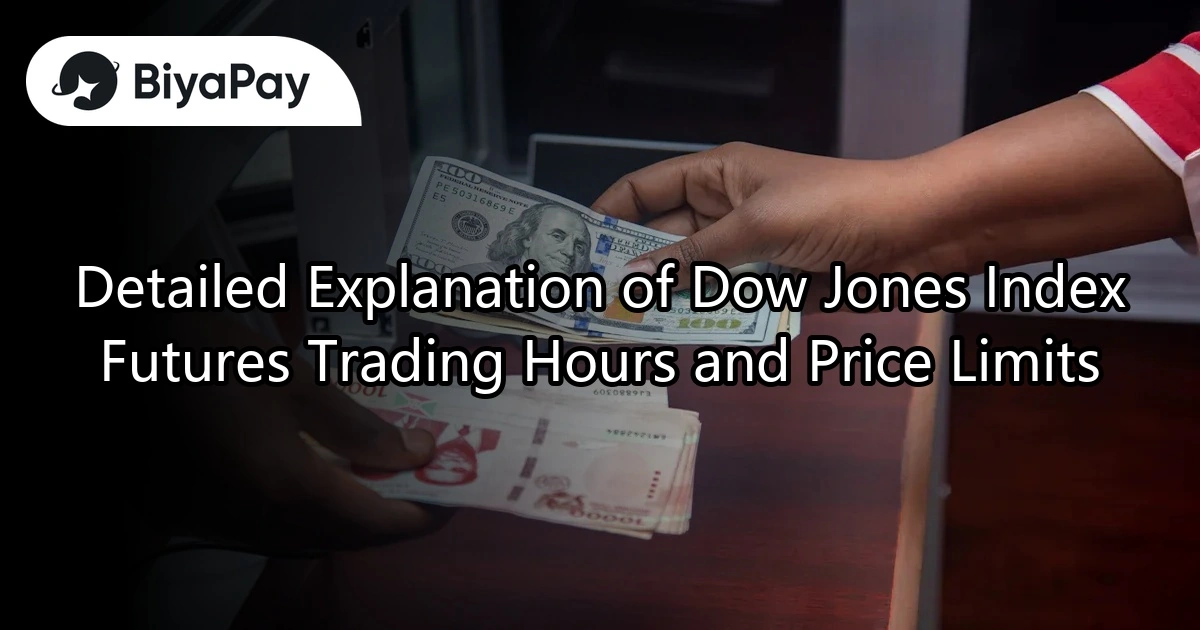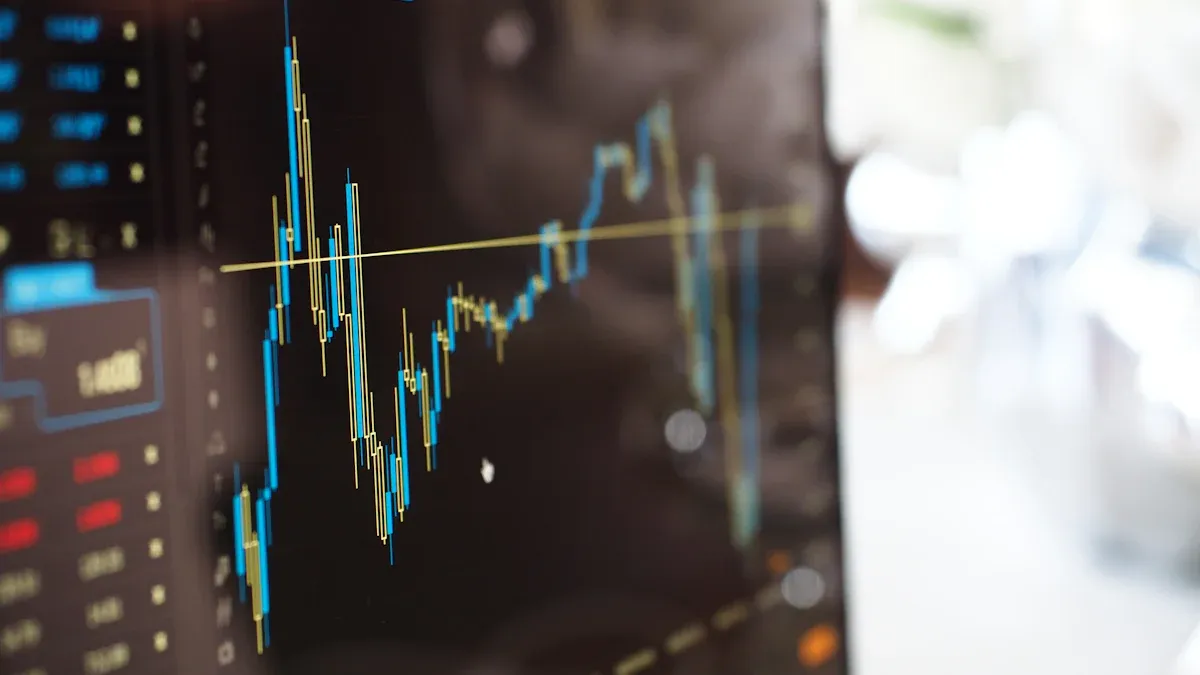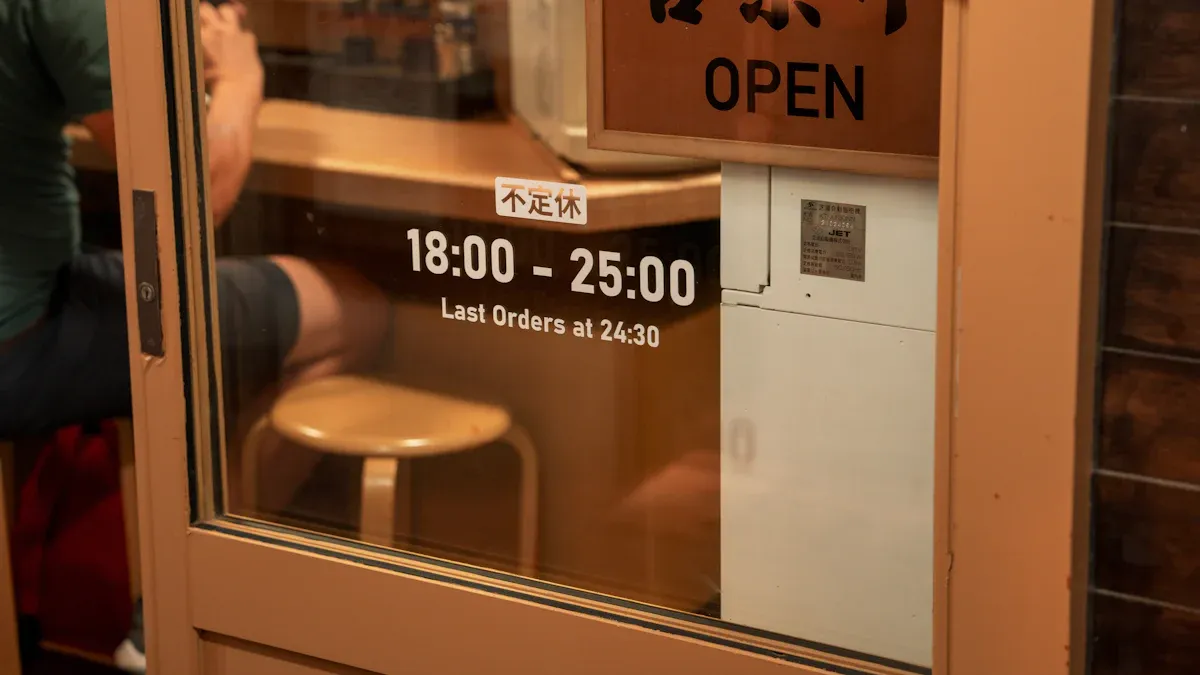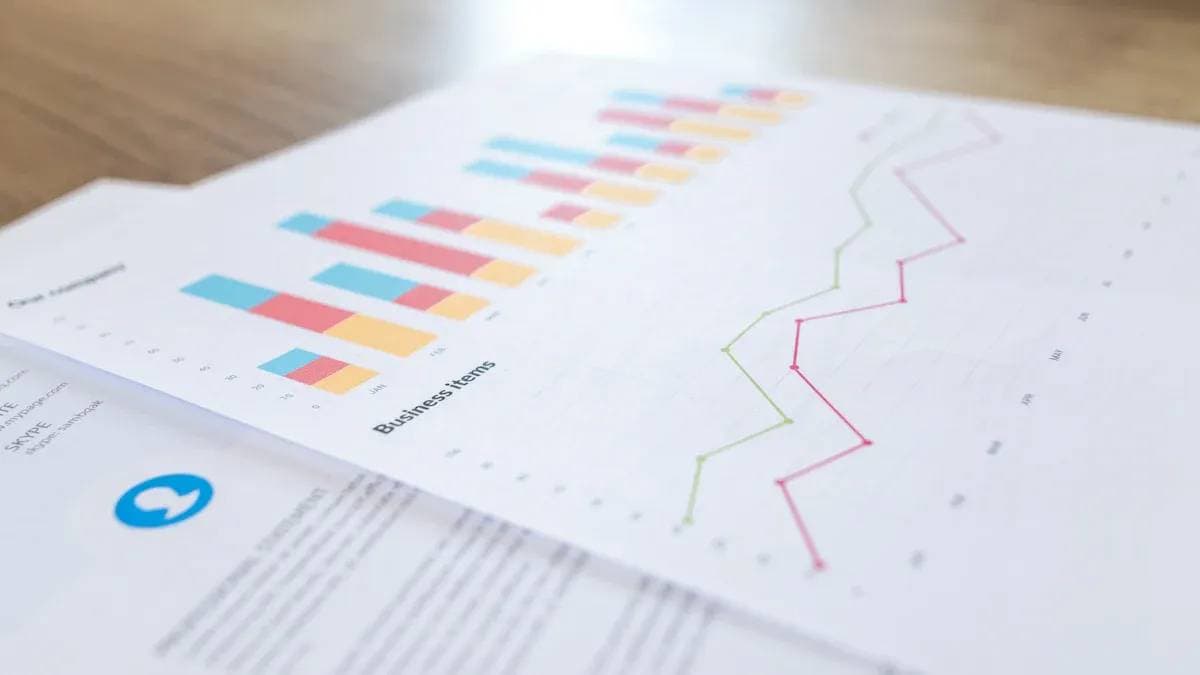- EasyCard
- Trade
- Help
- Announcement
- Academy
- SWIFT Code
- Iban Number
- Referral
- Customer Service
- Blog
- Creator
Detailed Explanation of Dow Jones Index Futures Trading Hours and Price Limits

Image Source: pexels
Understanding the trading hours and price limit rules of Dow Jones Index Futures can help you develop trading strategies with greater confidence. These rules not only affect the timing of trades but also directly impact your risk management capabilities. Mastering this foundational knowledge allows you to respond to market volatility more effectively, increasing your chances of successful trading.
Key Highlights
- The regular trading hours for Dow Jones Index Futures are from 9:30 AM to 4:00 PM Eastern Time, a period with high liquidity ideal for short-term trading.
- Overnight trading hours run from 4:00 PM to 9:30 AM the next day, with lower liquidity but opportunities to trade based on international market dynamics.
- Daily price movement limits prevent excessive price volatility, and traders should closely monitor market changes near these limits to adjust strategies.
- Circuit breaker mechanisms pause trading during extreme market volatility, giving investors time to reassess market conditions, serving as a key risk management tool.
- Understanding trading hours and price limits can help you develop more effective trading plans, improving efficiency and success rates.
Detailed Explanation of Dow Jones Index Futures Trading Hours

Image Source: pexels
Regular Trading Hours Arrangement
The regular trading hours for Dow Jones Index Futures typically align with the opening hours of the U.S. stock market. This period provides traders with the primary opportunities for market activity. Based on Eastern Time (ET), regular trading hours start at 9:30 AM and end at 4:00 PM. During this time, market liquidity is high, and price fluctuations are relatively frequent.
Within this period, you can observe the market’s immediate reactions to economic data, corporate earnings reports, and other significant news. These factors directly influence the price movements of Dow Jones Index Futures. If you are a day trader, this period is the golden time for formulating short-term strategies.
Characteristics of Overnight Trading Hours
Overnight trading hours provide additional opportunities for investors looking to trade outside regular hours. This period typically runs from 4:00 PM to 9:30 AM the next day. Although liquidity is relatively lower during overnight trading, it still attracts many international investors, particularly those from Asia and Europe.
One characteristic of overnight trading is that price movements may be influenced by international markets. For example, economic data from Asian markets or policy changes in European markets may impact the price of Dow Jones Index Futures during this period. If you aim to capitalize on these international market dynamics, overnight trading is a worthwhile option to consider.
Comparison of Trading Hours Across Different Exchanges
Different exchanges may have slightly different trading hour arrangements for Dow Jones Index Futures. Below is a simple comparison table to help you quickly understand the trading hours of major exchanges:
| Exchange Name | Regular Trading Hours (ET) | Overnight Trading Hours (ET) |
|---|---|---|
| Chicago Mercantile Exchange | 9:30 AM - 4:00 PM | 4:00 PM - 9:30 AM |
| Hong Kong Stock Exchange | 9:30 AM - 4:00 PM | 5:15 PM - 3:00 AM |
| European Futures Exchange | 9:30 AM - 4:00 PM | 5:00 PM - 8:00 AM |
These differences in trading hours are primarily designed to meet the needs of investors in different regions. If you plan to trade across multiple exchanges, familiarizing yourself with these schedules will help you better plan your trading activities.
Trading Hours Table Overview
Understanding the trading hours table for Dow Jones Index Futures can help you quickly grasp the market’s operational rhythm. Below is a simple table outlining the regular and overnight trading hours:
| Session Type | Start Time (ET) | End Time (ET) |
|---|---|---|
| Regular Trading Hours | 9:30 AM | 4:00 PM |
| Overnight Trading Hours | 4:00 PM | 9:30 AM (Next Day) |
This table clearly shows the time ranges during which traders can participate in the market. You can choose the appropriate session for trading based on your strategy.
Tip: While liquidity is lower during overnight trading, it offers opportunities to observe international market dynamics. Economic data from Asia and Europe, in particular, may influence futures prices during this period.
Additionally, technological advancements are transforming market operations. The rise of algorithmic trading has made markets more efficient. Here are some related trends:
- The demand for government regulation and efficient order execution has driven the growth of the algorithmic trading market.
- The development of artificial intelligence technology has created more opportunities for algorithmic trading in financial services.
- The technological revolution has transformed business operations, further promoting market automation.
- The COVID-19 pandemic accelerated reliance on technology, boosting the adoption of algorithmic trading.
These trends indicate that future trading markets will increasingly rely on technology. As a trader, you can consider how to leverage these technologies to improve your trading efficiency.
Detailed Explanation of Dow Jones Index Futures Price Limit Rules

Image Source: unsplash
Rules for Daily Price Movement Limits
Daily price movement limits are a critical rule in the futures market. Their purpose is to prevent excessive price volatility in a short period, thereby protecting investors’ interests. For Dow Jones Index Futures, daily price movement limits are typically set as a percentage range based on the previous trading day’s settlement price. For example, when price fluctuations exceed the set upper or lower limit, trading will pause until prices return to the allowed range.
This rule is highly important for you as it directly impacts your trading strategy. When the market approaches the price limit, liquidity may decrease, and price volatility may become unstable. You need to closely monitor market changes and adjust your trading plan based on the limit range.
Tip: When developing trading strategies, always consider the impact of daily price movement limits. This can help you avoid potential losses due to excessive price volatility.
How Circuit Breaker Mechanisms Work
Circuit breaker mechanisms are a safety measure designed to address extreme market volatility. When market prices experience sharp fluctuations in a short time, circuit breakers pause trading, giving market participants time to calm down and reassess the situation. These mechanisms typically have multiple levels, each corresponding to different price fluctuation thresholds.
For Dow Jones Index Futures, when price fluctuations reach a certain circuit breaker level, trading pauses for 15 minutes. If prices continue to fluctuate and hit a higher-level circuit breaker, trading may pause for a longer period or even halt for the day. This arrangement aims to prevent market panic from spreading and maintain market order.
Circuit breakers are an important risk management tool for you. When the market triggers a circuit breaker, you can use this time to reassess your positions and adjust your trading strategy based on market conditions.
Role of Price Limits in Market Stability
Price limits and circuit>manual
System: circuit breakers work together to play a crucial role in maintaining market stability. Their primary purpose is to reduce excessive market volatility and prevent market disruptions caused by panic selling or irrational buying. These measures also enhance investor confidence in the market, attracting more participants.
For you, price limits provide a relatively stable trading environment. When market prices approach the limit range, you can use this information to predict potential market movements and formulate corresponding trading plans. For example, when prices approach the upper limit, it may attract more buyers, leading to a short-term price pullback. These market behaviors can serve as key references for your strategy.
Data Insight: Historical data shows that implementing price limits effectively reduces market volatility, particularly during economic data releases or major events. This further demonstrates the positive role of price limits in market stability.
Case Study: Impact of Price Limits on Trading Decisions
Price limits have a significant impact on trading decisions, especially during periods of high market volatility. The following examples illustrate how you can use price limits to optimize your trading strategy.
Example 1: Avoiding Panic Selling
Suppose the price of Dow Jones Index Futures drops rapidly due to sudden economic data, approaching the daily lower price limit. This may trigger panic among investors, leading many to sell their contracts hastily. However, the existence of price limits can temporarily halt trading, giving market participants time to calmly analyze the situation.
For instance, when prices approach the lower limit, you can choose to wait and observe, waiting for market sentiment to stabilize before making decisions. This strategy can help you avoid losses due to emotional trading.
Example 2: Leveraging Upper Price Limits for Short-Term Trading
In another scenario, when Dow Jones Index Futures prices approach the upper price limit, the market may attract more buyers, leading to a short-term price pullback. You can leverage this characteristic for short-term trading strategies. For example, when prices near the upper limit, you can sell at a high price and wait for a pullback to buy back in.
This strategy requires you to closely monitor market dynamics and execute trading plans quickly. The stability provided by price limits allows you to execute such trades with greater confidence.
Example 3: Application in Risk Management
Price limits also help you manage risk more effectively. Suppose you hold a long position, and the market price suddenly drops, approaching the lower limit. You can use the pause in trading caused by the price limit to reassess the market situation and decide whether to close your position or adjust your holdings.
For example, if you determine that the market decline is due to short-term factors, you may choose to hold your position and wait for a price recovery. Conversely, if the decline is driven by long-term negative factors, you might close your position promptly to minimize potential losses.
Example 4: Strategic Adjustments for Long-Term Investors
For long-term investors, price limits provide a relatively stable market environment. When market prices approach the lower limit, you can consider increasing your position to buy high-quality assets at a lower price. This strategy can help you achieve higher returns when the market rebounds.
Tip: When formulating trading plans, always consider the impact of price limits. This not only helps you better manage market volatility but also enhances your trading efficiency.
The impact of price limits on trading decisions is evident not only in risk management but also in seizing market opportunities. By deeply understanding these rules, you can respond to market changes more flexibly and achieve stable profits.
Practical Applications of Trading Hours and Price Limits
Formulating Day Trading Strategies
Day trading requires you to make quick decisions in a short time. Dow Jones Index Futures trading hours are divided into regular and overnight sessions. You can choose the appropriate session based on your schedule. Regular trading hours offer high liquidity, ideal for short-term traders to profit from price fluctuations. Overnight trading provides opportunities to observe international market dynamics, particularly from Asian and European markets.
When formulating day trading strategies, you should closely monitor market opening and closing times. These periods often come with significant price fluctuations, providing more trading opportunities. For example, price jumps at the opening may reflect overnight market influences, while the closing period may see volatility due to investors closing positions.
Application of Price Limits in Trend Trading
Trend traders typically focus on long-term market trends, and price limits provide a stable trading environment. When market prices approach the upper or lower limits, you can use this information to gauge market trends. For instance, when prices approach the upper limit, it may indicate strong buying sentiment. You can choose to follow the trend and increase your position.
Additionally, price limits help you avoid misjudgments due to excessive market volatility. When prices approach the lower limit, you can reassess the market situation to ensure your trading decisions align with the trend.
Risk Management Strategies: Combining Trading Hours and Price Limits
Risk management is key to successful trading. You can combine trading hours and price limits to develop more effective risk management strategies. For example, during regular trading hours, you can leverage high liquidity to close positions quickly, reducing the impact of market volatility. During overnight trading, you can reduce your position size to avoid potential losses due to lower liquidity.
Price limits provide an additional risk control tool. When market prices approach the upper or lower limits, you can use this time to reassess your holdings. For example, when prices approach the lower limit, you can choose to reduce or close your position to avoid further losses.
Tip: When formulating risk management strategies, always consider the impact of trading hours and price limits. This helps you better manage market volatility and achieve stable profits.
Successful Trading Case Studies
Successful trading case studies can help you better understand how to apply trading hours and price limits in practice. Below are some noteworthy examples showcasing how traders use these rules to achieve profits.
Case Study 1: Capturing Market Volatility Using Trading Hours
A day trader successfully captured market volatility during regular trading hours. They entered the market at the opening session, as this period often comes with significant price movements. When the market surged rapidly due to major economic data releases, they decisively increased their position and closed it before the price approached the upper limit. This trade not only yielded significant profits but also highlighted the importance of trading hours for short-term strategies.
Case Study 2: Price Limits Assisting Risk Management
Another trader faced a situation during overnight trading where the market price approached the lower limit. They used the pause in trading caused by the price limit to reassess the market situation and decided to reduce their position to lower risk. This operation avoided further losses and allowed them to re-enter the market after stabilization, ultimately achieving profits.
Case Study 3: Strategic Adjustments for Long-Term Investors
A long-term investor chose to increase their position when the market price approached the lower limit. By evaluating the quality of potential assets, they identified those with long-term value and bought at a lower price. This trade demonstrated the importance of understanding budget constraints and effectively addressing price objections. Ultimately, they achieved higher returns when the market rebounded.
Tip: The key to successful trading lies in keen observation of market dynamics and flexible application of rules. You can adapt the above case studies to your trading style to develop suitable strategies.
These case studies demonstrate how trading hours and price limits help traders achieve profits in various scenarios. By deeply understanding these rules, you can find your own path to success in the market.
The trading hours and price limits of Dow Jones Index Futures are the foundation for formulating market strategies. Mastering these rules can help you manage risk more effectively and improve trading efficiency. Here are some key points:
- U.S. futures markets operate nearly 24 hours, but major volatility is concentrated in key sessions. You don’t need to monitor the market all day.
- Futures trading hours typically align with or are close to the trading hours of the underlying index, with different markets having different arrangements.
Deeply learning this knowledge will enable you to trade with greater confidence in the market and achieve stable profits.
FAQ
1. Do Dow Jones Index Futures trading hours change due to holidays?
Yes, trading hours may be adjusted due to major U.S. holidays. For example, during Thanksgiving and Christmas, exchanges typically shorten trading hours or close entirely. You should check the exchange’s official announcements in advance for specific arrangements.
2. Is overnight trading suitable for novice investors?
Overnight trading has lower liquidity, and price volatility may be influenced by international markets. For beginners, this may increase trading risks. If you’re new to trading, it’s advisable to focus on regular trading hours to familiarize yourself with market operations before considering overnight trading.
3. Will circuit breaker mechanisms affect my trading plan?
Yes. Circuit breakers pause trading to allow the market to calm down. When a circuit breaker is triggered, you need to reassess your holdings and adjust your strategy. Understanding circuit breaker levels and triggers can help you better handle such situations.
4. Do price limits affect market liquidity?
Price limits may temporarily reduce market liquidity, especially when prices approach upper or lower limits. At such times, trading interest from buyers and sellers may decrease. You should closely monitor market dynamics and avoid large trades during low liquidity periods.
5. How can I use the trading hours table to improve trading efficiency?
You can use the trading hours table to select high-liquidity periods for trading. For example, regular trading hours are ideal for short-term trading, while overnight trading offers opportunities to observe international markets. Align your trading goals and schedule with the table to enhance efficiency.
Tip: Regularly review the trading hours table and adjust your strategy based on market changes to respond to volatility more flexibly.
Dow Jones futures trading hours (regular session 9:30 AM–4:00 PM ET, overnight 4:00 PM–next day 9:30 AM ET) and price limits (daily caps, circuit breakers) offer traders flexibility and risk management tools, but how can you reduce cross-border costs and enhance capital efficiency? BiyaPay provides a digital financial platform, enabling seamless trading in U.S. and Hong Kong markets without offshore accounts, complementing Dow Jones futures with broader market access.
Supporting USD, HKD, and 30+ fiat and digital currencies with real-time exchange rate tracking for transparency, plus global remittances to 190+ countries with fees as low as 0.5%, it outperforms traditional banks’ costly processes. A 5.48% annualized yield savings product with no lock-in period ensures balanced returns and liquidity. Sign up for BiyaPay now to combine Dow Jones futures strategies with BiyaPay’s digital asset investment solutions for efficient, low-cost wealth growth!
*This article is provided for general information purposes and does not constitute legal, tax or other professional advice from BiyaPay or its subsidiaries and its affiliates, and it is not intended as a substitute for obtaining advice from a financial advisor or any other professional.
We make no representations, warranties or warranties, express or implied, as to the accuracy, completeness or timeliness of the contents of this publication.




Contact Us
Company and Team
BiyaPay Products
Customer Services
is a broker-dealer registered with the U.S. Securities and Exchange Commission (SEC) (No.: 802-127417), member of the Financial Industry Regulatory Authority (FINRA) (CRD: 325027), member of the Securities Investor Protection Corporation (SIPC), and regulated by FINRA and SEC.
registered with the US Financial Crimes Enforcement Network (FinCEN), as a Money Services Business (MSB), registration number: 31000218637349, and regulated by FinCEN.
registered as Financial Service Provider (FSP number: FSP1007221) in New Zealand, and is a member of the Financial Dispute Resolution Scheme, a New Zealand independent dispute resolution service provider.



















